Public cloud is the most used among organizations and individuals among the three models of cloud computing. It is an environment where IT resources are shared across many users via the public Internet. Examples of public cloud services are Gmail and Yahoo Mail.
Third-party providers such as Microsoft and Amazon have and use public clouds. Your purchase, manage and maintain the servers, data centers, and IT infrastructure needed to work with public cloud environments. On the other hand, users can easily rent the IT resources they need from providers over the Internet. Therefore, the cost of supporting a public cloud space is distributed among all users of the service.
In this article, we will talk about the public cloud, its advantages, and disadvantages.
What is Public Cloud?
Public cloud is a standard model of cloud computing service that is available to the general public. Public cloud is commonly used in conjunction with cloud computing and cloud computing. What most users apply as the concept of cloud computing refers to the public cloud. Amazon and Google Cloud Google are the most popular public clouds that offer a wide range of cloud computing services to the general public.
A public cloud is a collection of virtual resources. These resources are powered by hardware owned, managed, and organized by a third party company. Aids in the public cloud are automatically provided and allocated to multiple clients through a self-service interface.

In the public cloud, you will pay as much as you consume
In public clouds, the terms of use are pay-as-you-go. Resources and services are allocated to users only when they need them, and they only pay as much as they consume resources.
Public cloud is perhaps the simplest type of cloud computing service deployment. When a customer needs more resources, operating systems, or software, they can pay for an hour or a certain amount of space and use them exactly as much as they need. Just like the services that make up your home infrastructure, you do not need to know how water and gas are supplied to the building and electricity to your home wiring, and you do not have to worry or worry about providing them. Use them only when you need them and pay for them at the end of the month.
How does a public cloud work?
In the public cloud, infrastructure, processing power, storage space, or cloud computing-based software virtualized by the service vendor are aggregated in data lakes and made available to customers via the Internet or a dedicated network connection.
Customers do not need to buy gigabytes of hard drives. Customer files and data are stored on a server farm without managing and maintaining servers and hardware. The customer does not interfere in the installation, configuration, maintenance, and security of the required operating systems and software. There is only one commitment between the customer and the seller: use the resources or software you need and pay as much as you can.
But keep in mind that you can not have complete and convincing control over the infrastructure you use when using the public cloud. You will never know which part of the infrastructure users, applications, data, and packages are running and stored, and you can minimize the risk of using cloud computing on a public cloud.
Public cloud infrastructure:
The public cloud is a fully virtualized environment. Also, providers have a multi-tenant infrastructure that enables users or tenants to share computing resources. Each user’s information is separated from other users in the public cloud. The public cloud also relies on high-bandwidth connectivity for fast data replication.
The service model can further categorize public cloud architecture.
Standard service models include:
Software as a service (SaaS) in which a third-party provider hosts applications and makes them available to customers on the Internet.
Platform as a Service (PaaS), in which a third-party provider provides hardware and software tools that typically need to extend the application to their users as a service.
Infrastructure as a Service (IaaS), in which a third-party provider provides virtualization computing resources, such as virtual machines and Internet storage.
The future of public clouds
Today, public clouds are not being developed as a stand-alone solution to the cloud computing
infrastructure. Instead, a heterogeneous mix has emerged that has led to increased security and performance, further reduced costs, and broader capabilities in infrastructure, services, and applications.
In recent years, large corporations have adapted cloud capabilities to shift cloud services from just a public cloud or private cloud to a hybrid cloud. The hybrid cloud addresses public cloud security concerns in proprietary services while providing flexibility, scalability, and proprietary security for cloud-specific services. In this way, with the hybrid cloud, you can make the most of the advantages of the public cloud and the private cloud, and avoid each well’s disadvantages.
Cloud storage
Backup Cloud Storage with free upload and unlimited downloads is your personal and business file storage solution. External hard drive, flash memory, download host, upload center, internal server, and dedicated data center are redefined in the backup cloud storage.
<<Cloud Computing>> Advantages and Disadvantages of Public Clouds
Today, more and more companies are using cloud computing to access, process, manage and store critical commercial data and resources.
This allows them to consume computing power on a pay-per-view basis, resulting in significant savings and countless other business benefits.
Advantages of Public cloud
Initial costs
You do not have to accept high costs because external service providers use public cloud environments. Instead, you pay a fixed monthly subscription fee, sometimes with a low initial setup fee.
Costs are based on the actual load and volume of data used. There is no investment cost for the hardware. Companies that have work fluctuations benefit from a usage-based payment model.
Scalability
All the resources you need are well scaled. This is a considerable advantage, especially for companies whose usage pattern is difficult to calculate. Free scalability is available in vertical and horizontal versions.
Also, because there are multiple users of the public cloud environment, you will benefit from economies of scale. The more users, the lower the average cost. For this reason, the public cloud is the cheapest option among cloud computing delivery models.
Reliability
Public cloud providers store their servers in data centers protected by enterprise-level security and climate control measures to prevent system crashes. Also, their data centers are spread all over the world. So, if one data center suffers a power outage or disaster, another data center can immediately use it as a backup to ensure maximum uptime.
Easier deployment
Whenever you have a new project that requires computing resources, you can immediately rent the help you need from your provider because they are readily available. Companies such as Amazon, Google, and Microsoft make petabytes available on-demand and provide in-company services, security, and management.
Scalability and flexibility
you can quickly increase or decrease your scale Because you only pay for the resources you need. With just a few mouse clicks, you can improve your resource allocation to meet more demand during the busy season. In the active months, you can do the reverse thing quickly.
In a public cloud, you can increase or decrease resources according to your needs. It enables companies to respond quickly and flexibly to changing business needs.
Access to advanced technology
Public cloud providers are continually updating their hardware and software to maintain their competitive advantage. So it allows access to the latest technologies such as artificial intelligence, Kubernetes, and big data.
Public cloud scores with high availability because service providers operate in professional data center environments and offer convenient backup solutions.
automation
Public Cloud offers a variety of automation options for specific technologies such as containers, methods such as DevOps, as well as for security, testing, monitoring, and alerting.
Ready service
Companies benefit from publicly available services such as PaaS, SaaS, and IaaS. You can use these items according to your personal needs.
The public cloud is valuable for companies operating internationally. They do not need to build or use their infrastructure in their respective countries.
saving time
The public cloud provides instant access to customers. You can update mobile apps and websites several times a day. Due to the high speed, you can significantly reduce the runtime.
What are the disadvantages of using a public cloud platform?
Possible security and compliance issues
As third parties own and control the public cloud environment, you have no direct control over things like data storage, software updates, and security measures. This feature can be problematic for companies owned by highly regulated industries such as healthcare and finance. Compliance issues can prevent you from migrating some sensitive information (such as protected health information) to the public cloud, as this requires a higher level of security and privacy of user data.
Dealer lock
If you change the public cloud provider, you will not transfer the infrastructure that works there one by one to the new provider. When switching, there are always immigration efforts and costs. However, by optimizing and adapting your software, you can reduce some of your respective public cloud providers (lock effect).
incompatibility
Because the public cloud hosts multiple tenants, you can only customize it to some extent to suit your needs. So if you need a very complex network architecture or workflow, the public cloud may not be able to meet your needs.
Instead, you may need a private cloud or a hybrid cloud.
Managed Services – Solve public cloud challenges
Public clouds make sense in many situations. However, there is often a lack of sufficient responsibility and knowledge. You can solve these problems with managed services.
Cloud – In 3 steps for an effective migration
Turning to the cloud at a lower cost
To reduce costs, in the end, a provider tells you what to look for at each step.
Complexity and technical knowledge
The operation and maintenance of a public cloud system are involved. For this reason, a company with the right technical knowledge is needed for management. To better manage different services and ensure the public cloud’s smooth operation, many companies work with a managed cloud solution provider. They optimize you for the imagination, migration, and success of your cloud applications.
Without a monopoly
In a public cloud, multiple users share the same (computational) resources. The hardware used and the storage capacity and computing power do not belong only to the customer. However, you can reserve specific resources for a certain period to be exclusively available to you.
Cloud services can slow down companies if they are not optimized and maintained. With managed services, you can get the most out of the public cloud.

read about private cloud too
result
Public cloud is a standard model of cloud computing service that is available to the general public. Public cloud is commonly used in conjunction with cloud computing. What most users use, as the concept of cloud computing refers to the public cloud.
A public cloud is a collection of virtual resources. These resources are powered by hardware owned, managed, and organized by a third party company. Aids in the public cloud are automatically provided and allocated to multiple clients through a self-service interface.
Public cloud services may be free of charge or provided in a paid model for any use.
The public cloud is a powerful and standard IT solution. This infrastructure is freely accessible to the user via the Internet. Uses computing power, storage space, infrastructure, or applications.


